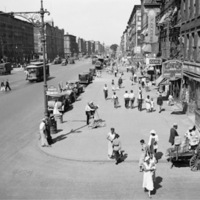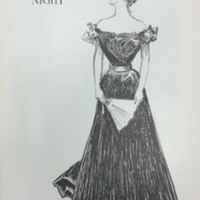Browse Items (160 total)
Sort by:
Lenox Avenue Clubs
Lenox Avenue was the most popular street in Harlem during the Harlem Renaissance. Lenox Avenue served as a major hub for African American culture during the Harlem Renaissance. Here, clubs and restaurants sprung up that featured some of the most…
Live Jazz
Jazz was a major part of the culture of 1920s. The newly available technology such as radio and phonographs allowed this type of music to be easily accessed by all groups. For one of the first times in history, it was easy for the general public to…
Tags: Harlem Renaissance, jazz, nightclubs
Lenox Avenue: A Symbol of Hope
“We have to-morrow
Bright before us
Like a flame”
(663, Hughes)
This quote from one of Langston Hughes’ many poems expresses the hope that African Americans have during the time of the Harlem Renaissance. Hughes refers to this bright future as…
Bright before us
Like a flame”
(663, Hughes)
This quote from one of Langston Hughes’ many poems expresses the hope that African Americans have during the time of the Harlem Renaissance. Hughes refers to this bright future as…
Tags: Harlem Renaissance, Hughes, Lenox Avenue
A Scene from Harlem in the 1920s
The exact location of this street scene in Harlem is unknown, however, it captures the energy, commerce and fashion in Harlem during the 1920s. As James Weldon Johnson described in The Making of Harlem, Harlem was a "self supporting community".…
Tags: class, fashion, Harlem Renaissance
Alberto Giacometti-- inspired by African Art?
Apparently a photograph from Life Magazine, showing Alberto Giacometti with a number of his sculptures. In form, they distinctly resemble the African art Alain Locke included in his article, "The Art of Our Ancestors," in the issue of Survey Graphic…
Tags: african art, giacometti, Locke, Alain, modernism
The Cotton Club
Harlem cabarets became an important part of the Harlem Renaissance. They acted as a casual setting where people could break away from the social norms of race and sexuality. They started as establishments for primarily colored people but soon whites…
Metropolitan Magazine 1895, "The New Woman" and "The March of Progress"
These articles appeared consecutively in the December 1895 issue of Metropolitan magazine. "The New Woman: What She Is and What She Does," profiles a series of so-called "New Women" who have occupations including that of department-store…
Tags: gender roles, New Woman, technology & science, women
A New York Day: Night
This series of illustrations was created by Charles Dana Gibson and is titled “A New York Day: ‘Night’” (573-577). This was featured in the November monthly issue of Scribner’s Magazine. Charles Dana Gibson was a famous graphic artist who is best…
Tags: fashion, gender roles, Scribner's Magazine, women
Children in the Silent Protest Parade, 1917
This image depicts the Silent Protest Parade on July 28th, 1917, which consisted of 8,000 to 10,000 African Americans protesting the lynching of African Americans and black violence. Civil Rights activist W. E. B. Du Bois and the NAACP organized this…
Tags: class, race, Social Problems
Jewish Immigrants Coming to America
The image shows Jewish immigrants en route to America, probably via Ellis Island as it served as the main hub for the immigration of European Jews during the time. The image not only shows Jewish migrants but how the US would start becoming a melting…
Tags: 1890s, Immigrants
Cornell vs. UPenn, Dec. 30, 1899
The item chosen is an example of sports journalism back in the 1890s, a summary of a college football game played between Cornell University and the University of Pennsylvania, where each team is described in great detail about their season and what…
Tags: 1890s, Collier's Weekly, New York City, sports
Undergraduate Life at Smith College
The item I choose to analyze is an article called “Undergraduate Life at Smith College” This article gives a comprehensive description of what life is like for an average student at Smith College. The audience could be many people, but I believe it…
Tags: 1890s, New Woman, women, Women's Colleges, Women's Rights



















